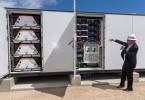NVision = higher power bills: Pending fuel-switch legislation could dramatically hike power rates
Can you envision much higher power bills?
NV Energy can, and the monopolistic utility is working right now in Carson City to ensure it rakes in higher profits as your electric rates go through the roof.
The proposal, too cutely dubbed NVision, has been introduced as Senate Bill 123 and would require the utility to shut down its coal-fired power plants and replace them with new natural gas-fired and renewable power plants.
Here’s the catch, however: The scheme requires ratepayers to continue paying for the coal plants that aren’t being used in addition to the new replacement plants.
NV Energy expects ratepayers to compensate it for the undepreciated value of the coal plants it wants to close ahead of schedule. NV Energy even wants ratepayers to reimburse the utility for the stockpiles of coal it has purchased but no longer wants to use!
This is a lucrative strategy for NV Energy shareholders because, as a regulated utility, the company is guaranteed a set 10.5 percent return on equity for the power plants it builds. Thus, if the utility can get the Legislature to pass new mandates requiring the construction of additional power plants and renewable facilities, shareholders pocket more money — even as ratepayers face higher costs.
In other words, Nevada’s regulatory structure — the one protecting NV Energy’s monopoly — gives the utility a perverse incentive to operate as inefficiently as possible. For shareholders, more inefficiency equals higher earnings.
In states without competitive retail electricity markets, the typical role of a public utilities commission is to ensure that a monopoly provider does not exploit this perverse incentive to construct unneeded facilities. That’s why virtually all decisions made by the monopoly utility must first be approved by the commission.
In the original draft of Senate Bill 123, however, NV Energy sought to strip away much of this protection. The utility proposed to remove all decisions related to its coal-switch plan from regulatory oversight. The resulting outcry from regulators and consumer advocates eventually produced an amendment reinstating some level of oversight.
Even with oversight, however, NVision will cost ratepayers dearly. And while NV Energy admits that rates will increase as a result of the plan, the company’s estimates of those increases are dramatically understated.
The utility says the plan will only cause rates to rise 2.59 percent faster over the next 10 years. However, the company’s calculations appear to be based upon today’s spot price for natural gas — currently trading at around $4.15 per million British Thermal Units (BTUs). And that’s a problem.
Natural gas prices are notoriously volatile — much more so than those for coal — and today’s price is hovering around a 12-year low. Just a few years ago, natural gas was more than three times as expensive, trading at more than $14 per million BTUs. These price differences dramatically change the cost of electricity generation at a natural gas-fired power plant.
A new study published by the Nevada Policy Research Institute — citing data from the U.S. Department of Energy — shows that, while electricity from natural gas is cost-competitive with coal at current market prices, that competitiveness quickly disappears when those volatile prices begin increasing.
At $4.15 per million BTUs, natural gas-powered electricity costs about 6.07 cents per kilowatt hour (kWh). For comparison, electricity from a new coal plant would cost around 5.61 cents per kWh. However, if natural gas prices increase to $8 per million BTUs, electricity generation jumps to 8.81 cents per kWh — a 45 percent increase.
Ratepayers would become vulnerable to short-term price volatility for natural gas under NVision. And the U.S. Department of Energy predicts natural gas prices will rise much faster than coal prices over the next several decades. By 2040, natural gas prices are expected to rise 141 percent, while coal prices are only expected to rise 45 percent.
These realities are why energy economists predict that similar legislation passed in Colorado will cause electricity rates there to rise by as much as 50 percent. That’s despite assurances made by that state’s monopoly utility that those rates will only rise by 2 percent. Now NV Energy is also predicting a mere 2 percent increase.
NVision is certain to cause Nevada’s highest-in-the-region electricity prices to spike even further, making businesses less competitive and taking more income away from Nevada households.
Hardest hit will be low-income families, because energy costs consume a larger share of their household incomes. And for high-tech businesses, manufacturers and data centers — all industries state policymakers repeatedly say they want to attract — Nevada would become even less inviting.
Nevertheless, NV Energy is making a big push in Carson City, having added some of Gov. Brian Sandoval’s top advisers to its payroll.
That’s not the kind of “juice,” however, that Nevadans need.
Geoffrey Lawrence is deputy policy director at the Nevada Policy Research Institute. For more visit http://npri.org.























